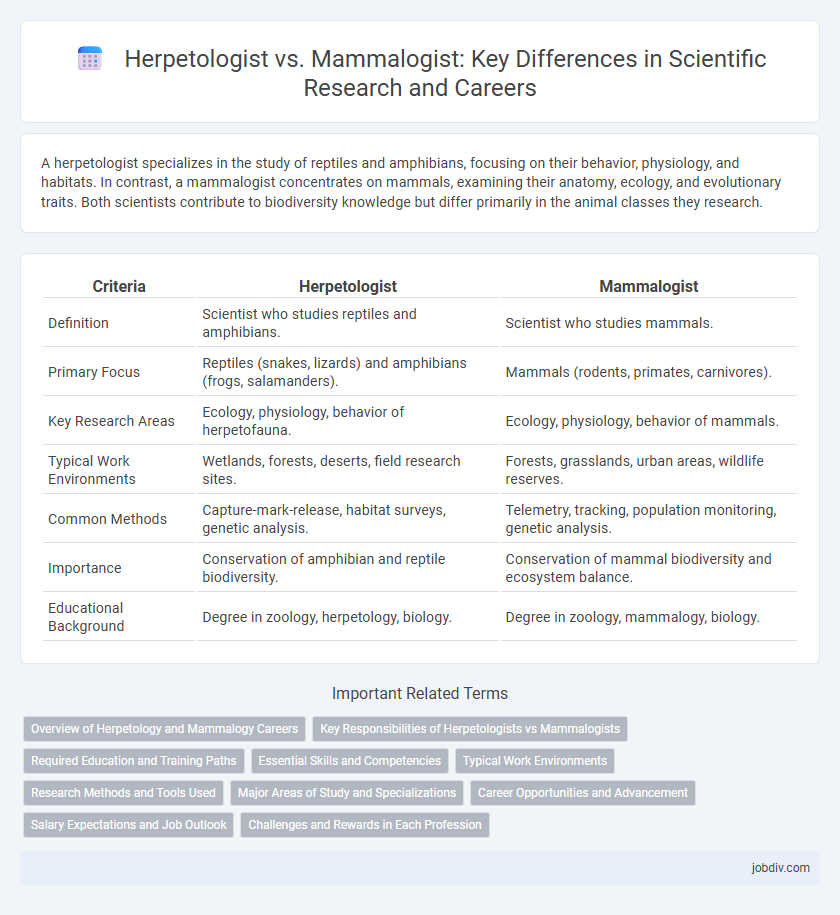A herpetologist specializes in the study of reptiles and amphibians, focusing on their behavior, physiology, and habitats. In contrast, a mammalogist concentrates on mammals, examining their anatomy, ecology, and evolutionary traits. Both scientists contribute to biodiversity knowledge but differ primarily in the animal classes they research.
Table of Comparison
| Criteria | Herpetologist | Mammalogist |
|---|---|---|
| Definition | Scientist who studies reptiles and amphibians. | Scientist who studies mammals. |
| Primary Focus | Reptiles (snakes, lizards) and amphibians (frogs, salamanders). | Mammals (rodents, primates, carnivores). |
| Key Research Areas | Ecology, physiology, behavior of herpetofauna. | Ecology, physiology, behavior of mammals. |
| Typical Work Environments | Wetlands, forests, deserts, field research sites. | Forests, grasslands, urban areas, wildlife reserves. |
| Common Methods | Capture-mark-release, habitat surveys, genetic analysis. | Telemetry, tracking, population monitoring, genetic analysis. |
| Importance | Conservation of amphibian and reptile biodiversity. | Conservation of mammal biodiversity and ecosystem balance. |
| Educational Background | Degree in zoology, herpetology, biology. | Degree in zoology, mammalogy, biology. |
Overview of Herpetology and Mammalogy Careers
Herpetology and mammalogy are specialized branches of zoology focusing on the study of reptiles, amphibians, and mammals, respectively, offering distinct career paths in research, conservation, and education. Herpetologists often engage in fieldwork to study species diversity, habitat requirements, and behavioral ecology of reptiles and amphibians, contributing to biodiversity preservation and wildlife management. Mammalogists investigate mammalian biology, physiology, and evolutionary adaptations, with career opportunities in wildlife biology, veterinary sciences, and ecological consulting.
Key Responsibilities of Herpetologists vs Mammalogists
Herpetologists specialize in the study of reptiles and amphibians, focusing on their behavior, physiology, and conservation, often conducting field research to monitor populations and habitats. Mammalogists concentrate on mammals, researching their anatomy, genetics, and ecological roles, while also addressing conservation challenges and disease control. Both experts employ data collection, species identification, and habitat assessment techniques tailored to their respective animal groups.
Required Education and Training Paths
Herpetologists typically require a bachelor's degree in biology, zoology, or a related field, followed by specialized graduate studies focusing on amphibians and reptiles, such as a master's or Ph.D. in herpetology or wildlife biology. Mammalogists pursue similar undergraduate degrees but often advance to graduate programs emphasizing mammalian biology, ecology, or conservation, with research and fieldwork experience crucial for expertise. Both professions demand rigorous training in taxonomy, anatomy, field methods, and data analysis, with internships or field research enhancing practical skills for career success.
Essential Skills and Competencies
Herpetologists require expertise in reptile and amphibian biology, adeptness in field research techniques, and skills in species identification and habitat assessment. Mammalogists focus on mammal physiology, behavioral ecology, and possess competencies in tracking, population monitoring, and genetic sampling. Both specialists need strong analytical abilities, proficiency in data collection, and knowledge of conservation practices to effectively contribute to their scientific fields.
Typical Work Environments
Herpetologists primarily conduct research in diverse habitats such as wetlands, forests, and deserts to study reptiles and amphibians in their natural environments. Mammalogists work in a variety of settings including wildlife reserves, laboratories, and zoos to observe and analyze mammalian behavior and physiology. Both specialists may also engage in academic institutions and conservation projects to support ecological research and species preservation.
Research Methods and Tools Used
Herpetologists utilize field surveys, visual encounter surveys, and radio telemetry to study reptiles and amphibians, relying on tools such as pitfall traps, GPS devices, and environmental data loggers. Mammalogists employ camera traps, live trapping techniques, and molecular analysis to investigate mammal behavior, population dynamics, and genetics, often using specialized equipment like telemetry collars and DNA sequencers. Both disciplines integrate GIS technology and bioacoustic monitoring to enhance data accuracy and ecological understanding.
Major Areas of Study and Specializations
Herpetologists specialize in the study of reptiles and amphibians, exploring their behavior, physiology, ecology, and conservation efforts. Mammalogists focus on mammals, investigating their anatomy, genetics, evolution, and interactions within ecosystems. Distinct specialization areas for herpetologists include herpetofauna biodiversity and herpetological disease, while mammalogists emphasize mammalian taxonomy, reproductive biology, and habitat management.
Career Opportunities and Advancement
Herpetologists specializing in reptiles and amphibians often find opportunities in wildlife research, conservation agencies, and academic institutions, with career advancement linked to field expertise and publication record. Mammalogists, focusing on mammals, have broader prospects in ecological consulting, zoological parks, and biomedical research, benefiting from interdisciplinary collaboration and advanced degrees. Both careers demand continuous learning and may offer leadership roles in environmental policy and species management as professionals gain experience.
Salary Expectations and Job Outlook
Herpetologists typically earn between $50,000 and $80,000 annually, depending on experience and research funding, while mammalogists' salaries range from $55,000 to $90,000, often influenced by government or academic positions. Job outlook for both fields is projected to grow moderately by 6-8% over the next decade, driven by expanding wildlife conservation efforts and ecological research funding. Mammalogy may offer broader employment opportunities due to a wider focus on mammals, which are key to various ecosystems and public health studies.
Challenges and Rewards in Each Profession
Herpetologists face challenges like studying elusive reptiles and amphibians in diverse, often harsh habitats, requiring specialized knowledge of ectothermic physiology and environmental sensitivities. Mammalogists encounter difficulties tracking mammals with complex behaviors and large ranges, demanding extensive fieldwork and advanced tracking technology. Both professions offer rewards through contributions to conservation biology, biodiversity understanding, and ecosystem management, with opportunities for discovery and species preservation.
Herpetologist vs Mammalogist Infographic

 jobdiv.com
jobdiv.com